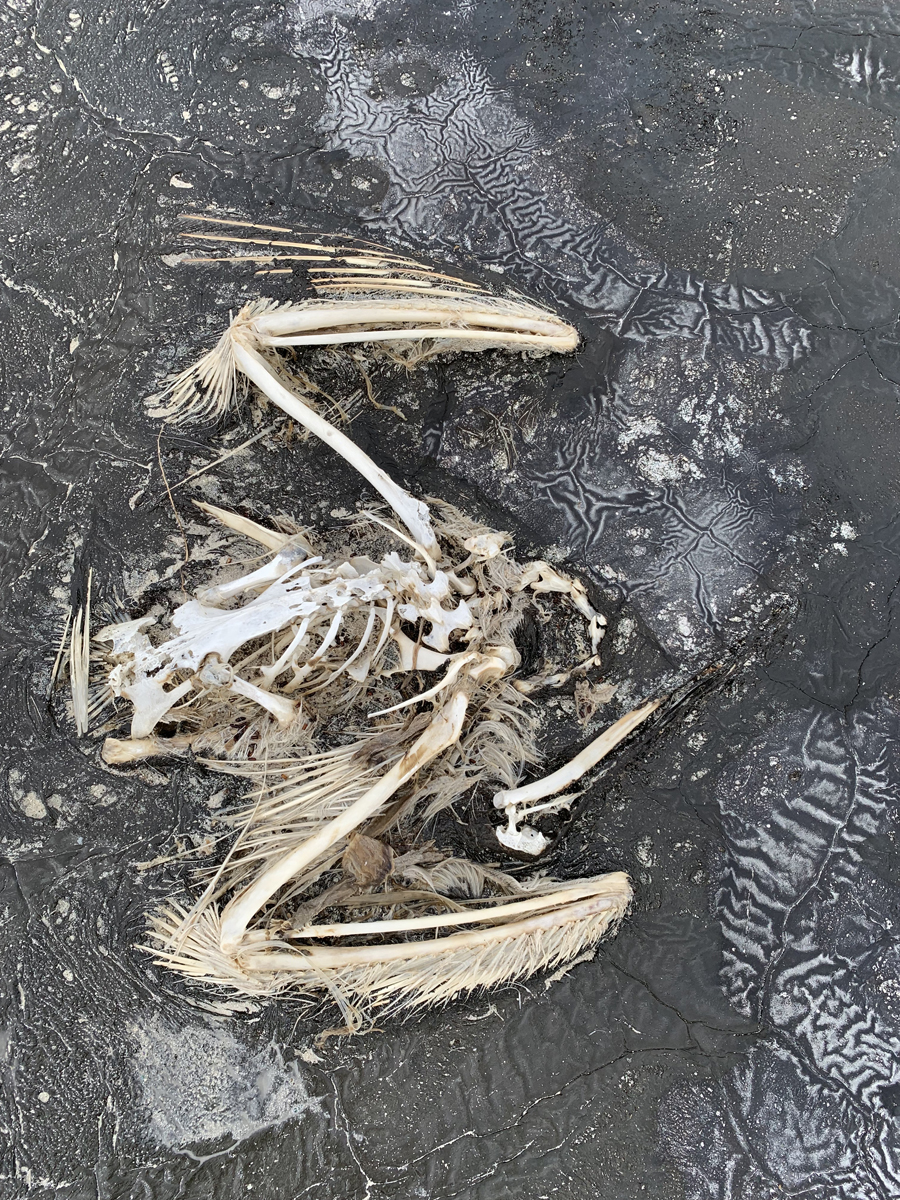Pelican
Pelecanus erythrorhynchos
—Feral
toward a migratory point of view
Medium: Intermedia photography from iPhone, drone, camera traps (2018-2021)
To take a photograph is to participate in another person’s (or thing’s) mortality, vulnerability, mutability … All photographs testify to time’s relentless melt.
Susan Sontag, On Photography¹
A pelican does not stay in one place as a plant or a tree or a mountain, which is rooted in a particular ecosystem and enlivened by what migrates² through it. A pelican crosses places, interconnecting the evolving, living planet. To think like a pelican, a migratory point-of-view is inherently comparative as it moves between ecosystems. A pelican’s perspective also crosses places over time, evolutionarily linking back to ancestral dinosaurs while traversing current day flyways.
Following pelicans, this photographic montage grows from tar seeps of natural asphalt at Rozel Point in Great Salt Lake, Utah. Nicknamed ‘death traps,’ tar seeps are pools of raw oil that creep up from tectonic fractures and spread across the earth like sticky flypaper. An unsuspecting bird that wanders through a melting seep can get fatally stuck. Off Rozel Point lies Gunnison Island: home to one of the largest breeding colonies of the American White Pelican in North America. Because pelicans fly from Gunnison Island over the tar seeps to feed at the Bear River Migratory Bird Refuge, some get stuck in the tar and leave a fossilized record of the lake’s life. Pelicans are among hundreds of bird species that migrate through Great Salt Lake. Despite often being likened to a dead sea, the lake is actually wildly alive and lies at the convergence of two of the four major migratory bird flyways of North America. Great Salt Lake is threatened by human overuse of natural resources and entangled with watersheds of the American West.
Migrating between media, this gallery entry integrates on-the-ground encounters with pelicans (through camera traps) and distant views (through iPhone and drone photographs) in an ongoing examination of migration through a singular place. The photographs are not chronological, simultaneously suggesting gaps and conflating years with moments, as time folds in consequentially. Camera traps are stamped in time, framing a moment triggered by motion. As the lightbox re-members individual images as a re-collection, a viewer can choose to zoom in close, maintain distance, or look away entirely.
Gretchen Ernster Henderson
—Migrating from Washington, DC
to Arizona, USA

Field Note: Pelican bones at tar seeps, Rozel Point, Great Salt Lake, Utah, March 24, 2019
Photograph, Gretchen Ernster Henderson
Warning:
One sequence of camera trap images reveals a pelican’s natural entrapment and death. This challenging inclusion in a virtual gallery might heighten a sense of spectatorship and passivity; yet bearing witness to natural processes, which often happen outside human view, may grow awareness of the complexities of living environments that humans otherwise may dismiss as already dead or dying while these continue to live.
This entry for PELICAN migrates across digital and print editions. To expand a migratory point of view, read the print entry in becoming—Feral.
To read more background, see “Life in the Tar Seeps,” published in the Winter 2019/2020 issue of Ecotone (Notable Essay in Best American Essays 2020). To move beyond visually-dominated sensibilities at Rozel Point, visit my short film on “Toward a Bird’s Eye View: Beyond mine, extracted” exhibited in Mining the West, presented by the Utah Museum of Fine Arts and J. Willard Marriott Library at the University of Utah (reproduced below). Grateful acknowledgment is made to the Great Salt Lake Institute (GSLI) for permission to reproduce their camera trap images. The GSLI continually works to steward Great Salt Lake with collaborative partners.
My book is forthcoming from Trinity University Press as Life in the Tar Seeps: Overlooked Ecologies at Great Salt Lake and Beyond.
from Life in the Tar Seeps: Overlooked Ecologies at Great Salt Lake and Beyond
Endnotes
1. Susan Sontag, On Photography (New York: Penguin, 1977), p.15.
2. Meanings of migration move like an animal between habitats for sustenance and survival. Patterned seasonal routes follow generational journeys. A migration follows instinct and evolution with etymological roots passing into a new condition or form (physical as a bird, effable as a soul) akin to mutation, change, and exchange. In the background lie growing migrations of the climate crisis.
